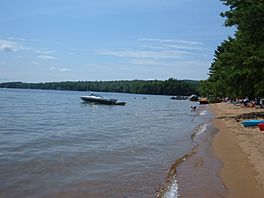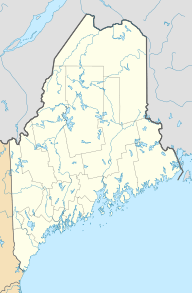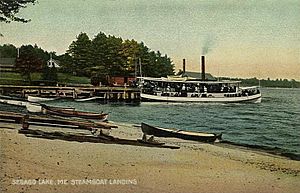Sebago Lake facts for kids
Quick facts for kids Sebago Lake |
|
|---|---|

A beach in Sebago Lake State Park
|
|
| Location | Cumberland County, Maine |
| Coordinates | 43°51′N 70°34′W / 43.850°N 70.567°W |
| Lake type | oligotrophic |
| Primary outflows | Presumpscot River |
| Catchment area | 440 square miles (1,100 km2) |
| Basin countries | United States |
| Max. length | 12 mi (19 km) |
| Surface area | 30,513 acres (12,348 ha) |
| Average depth | 107 ft (33 m) |
| Max. depth | 316 ft (96 m) |
| Water volume | 3,224,233 acre⋅ft (3.977033×109 m3) |
| Residence time | 5.1 to 5.4 yrs |
| Shore length1 | 105 miles (169 km) |
| Surface elevation | 267 ft (81 m) |
| Islands | Frye Island |
| Settlements | Casco, Naples, Raymond, Sebago, Standish and Windham |
| 1 Shore length is not a well-defined measure. | |
Sebago Lake is the deepest and second-largest lake in the U.S. state of Maine. The lake is 316 feet (96 m) deep at its deepest point, with a mean depth of 101 feet (31 m), covers about 45 square miles (117 km2) in surface area, has a length of 14 miles (23 km) and has a shoreline length of roughly 105 miles (169 km). The surface is around 270 feet (82 m) above sea level, so the deep bottom is below the present sea level. It is in Cumberland County, and bordered by the towns of Casco, Naples, Raymond, Sebago, Standish and Windham. The seasonally occupied town of Frye Island is on an island in the lake. Sebago Lake and the surrounding area is known for its erratic and sudden changes in weather during all seasons, likely due to its proximity to the Atlantic Ocean and to Mt. Washington, a very notorious extreme weather hotspot. Sebago means "big still water" in Abenaki.
Contents
Transportation
The lake is connected to Brandy Pond by the Songo River and eventually to Long Lake in Naples. The name comes from a local Native American tribe. The lake is drained primarily by the Presumpscot River. The lake and rivers were an early transportation corridor from the coast to the interior, and encouraged the first incorporated European settlement of interior Maine in 1762. Sebago Lake was linked to Portland harbor by the Cumberland and Oxford Canal in 1832. The outlet to the Presumpscot River was controlled for the canal by the Eel Weir Dam and the Head Dam, owned and operated by the Oriental Powder Company after the canal was replaced by a railroad and by the S. D. Warren Paper Mill after 1878.
The lake was a comparatively safe place for training military pilots from NAS Brunswick about flying over water; but several navy planes were lost over the lake during World War II. A Grumman TBF Avenger from the Lewiston Naval Auxiliary Air Facility ditched and sank near Raymond on 16 August 1943. Two low-flying British Vought Corsairs from Brunswick were lost after a mid-air collision over the lake near Raymond on 16 May 1944; and a third Corsair flew into the lake on July 16. In December 2014 a yellow Piper PA-18 Super Cub monoplane landed on a Sebago Lake beach, in what some believe is the first landing of a plane on Sebago beaches.
Water supply
Sebago Lake is the primary water supply for the Portland Water District, which serves the Greater Portland region and about 20% of Maine's population. The lake's watershed is more than 50 miles (80 km) long and covers parts of 24 Maine towns.
The lake holds roughly 995 billion US gallons (3.77×109 m3) of water that on average resides 5.1 to 5.4 years in the lake. The direct watershed is about 171 square miles (443 km2) of land plus the 45 square miles (117 km2) of the lake, and the indirect watershed about 190 square miles (490 km2) of land plus about 28 square miles (73 km2) of other bodies of water. As of May 1990, roughly 86% of the watershed was forests and fallow fields, 2.5% in active timber operations, 9.3% in residential, agricultural, and commercial use, and 2.2% used for other purposes. Water inflow is estimated at 544 million US gallons (2,060,000 m3) per day and outflow at 498 million US gallons (1,890,000 m3) per day, of which 24 million US gallons (91,000 m3)/day are for the water district.
Recreation
In 1938, Maine opened Sebago Lake State Park as one of its original five state parks. The area was a recreation center even before this. The park is now 1,400 acres (5.7 km2) (mostly forested), open year-round, and has facilities including two public boat launches and a 250-site campground. There are also numerous private campgrounds (like Point Sebago in Casco which is 775 acres (3.14 km2)), cottages, and other recreational facilities in the area.
Although the lake has many Public access sites, it is becoming increasingly difficult to access the lake by land or water for recreation due to new private developments taking over much of its shoreline. As a result, a vast majority of the lake's shoreline is private property or is otherwise off-limits to land-based recreation.
Sebago Lake hosts a sailing instruction and charter service and is located in what Maine's tourism industry refers to as the Western Lakes and Mountains Region.
Efforts are underway to complete the Sebago to the Sea Trail, a trail running 28 miles from Sebago Lake to Casco Bay, mostly following the path of the Presumpscot River.
Fishing
The lake is the likely point of origin of the landlocked salmon, stated in the species' scientific name (Salmo salar sebago). At one point, the entire watershed was under seawater, and the first populations of these marine animals became established as the land rose and seawaters retreated.
Other game fish that can be found in the lake include lake trout, brook trout, brown trout, largemouth bass,(particularly on the lake's West Side) and northern pike. Some of these are stocked by the state, either in the lake directly or in connected bodies of water, while others were introduced illegally. The state encourages anglers to kill, hold, and notify them of all northern pike taken in the lake because they were introduced illegally, are not native to the region, and could disrupt the lake ecosystem, including that of Sebago Lake's original fish species, such as the landlocked salmon.
Camp
Center Day Camp, a day camp run by the Jewish Community Alliance of Southern Maine, is located on the shores of Sebago Lake.
Camp O-At-Ka, founded in 1906, is located along a half mile of waterfront in the northwest corner of Sebago Lake.
Camp Sebago, a camp run by The Salvation Army is located on the southwestern corner of Sebago Lake.
Camp Wohelo, the original Camp Fire Girls camp (WOrk HEalth LOve) was established on Sebago Lake in 1907. Founded by Luther Halsey Gulick and Charlotte Vetter Gulick, known by their native American names of Timanous and Hiitini, the camp strove to teach independence and back woods skills to young girls aged 6–16. Wohelo is still strong today.





